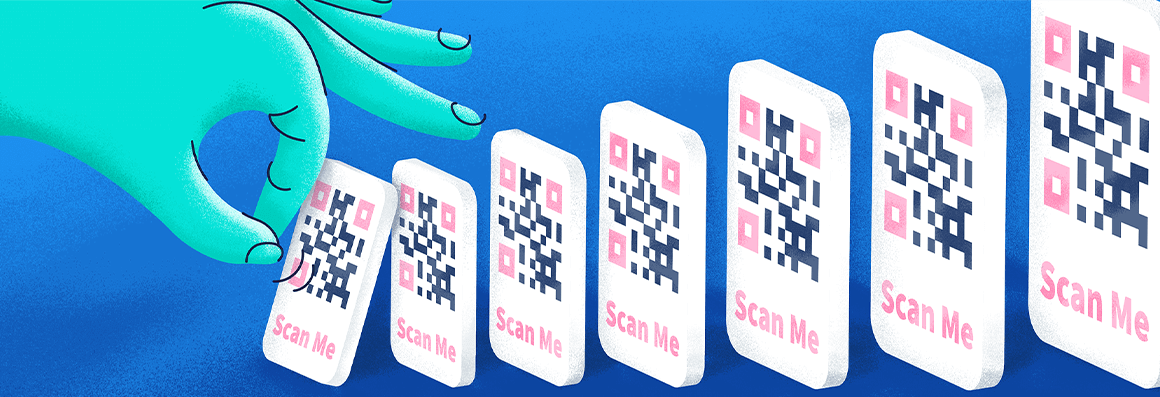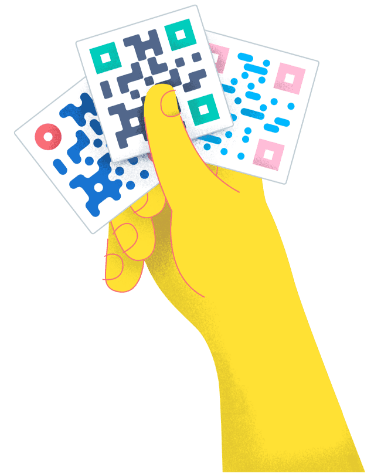- Best Practices ●
- COVID-19 ●
- Industry Trends ●
- Partners ●
- Product ●
What Are the Differences Between Aztec Codes vs. QR Codes?
One is a black and white square with lots of dots, and the other is a black and white square with—even more dots? To the untrained eye, an Aztec Barcode and a QR Code look similar in structure, but their design and applicability differ widely. But what are these differences? And where are they most often used?
If you need digital technology to promote your products and services, it’s important to make this distinction. Otherwise, you could choose the wrong type of code.
Get up to speed with the Aztec Barcode vs. QR Code, and understand the unique features of each type of code. First: the QR Code.
What is a QR Code?
A QR Code is a type of code that uses 2D technology, meaning it has a square shape, and a scanner can read it horizontally and vertically. Originally designed to improve stocktaking, places like warehouses and supermarkets have long used QR Codes for inventory management.
But before QR Codes existed, inventory management relied on linear barcodes—a 1D system to store information that held much fewer alphanumeric characters and data. In 1994, DENSO WAVE released QR Code technology to the public in Japan, and it could be used to manage inventory that had outgrown the need for two-dimensional barcodes.
If you’d like to learn more about the history of QR Codes, check out our guide to “What is a QR Code, and how does it work?”
How do QR Codes work?
We’ll start with some QR Code basics. QR Codes consist of seven major elements, resulting in a structure a bit like a crossword puzzle made of pixels. These elements determine how a scanner should read the QR Code, what version the QR Code is, how much data it holds, the quiet zone settings, and more.
The more data that is added to a QR Code, the denser the pixels become. A QR Code can hold up to 4,296 alphanumeric characters, and it has an adjustable error tolerance of up to 30%. There is also no limit to how big a QR Code should be, but there is a minimum QR Code size (2 x 2 cm or 0.8 x 0.8 in).
What is a QR Code used for?
While they might have begun their technology journey in the supermarket industry, QR Codes are used for so much more. Due to their flexibility in data storage capacity, ability to connect print to digital, and other uses, they have become popular on a global scale.
A plethora of industries use QR Codes for everything from sales to marketing. Depending on the scenario, Dynamic QR Codes—a QR Code encoded with a redirect URL—may be used for sharing different kinds of digital information, including videos, images, social media profiles, and event registration.
How to scan QR Codes
You can scan QR Codes with any third-party app via smartphone or tablet. In newer models, QR Code scanning technology has been integrated into the camera itself, which makes scanning a QR Code as simple as opening your camera and pointing the lens at the code.
If you’re unsure about how this might work with your phone, our guide on how to scan a QR Code will give you a better idea.
What is an Aztec Code?
An Aztec Code is a scannable data matrix barcode that you can encode with a specific set of alphabetic, numeric, or binary data. This type of barcode uses 2D technology, which means a scanner can read it horizontally and vertically. The interactive square bullseye finder pattern moves in pixelated layers from the center outward.
An upgraded version of the barcode, the Aztec Code was invented by Robert M. Hussey and Andrew Longacre in 1995. Aim, Inc. purchased the patent and officially released the technology to the public in 1997. While traditional 1D barcodes are only readable horizontally, Aztec Barcodes are similar to a QR Code in that they also use 2D technology.
Why Aztec? When viewed from above, the mysterious, flat-topped Aztec pyramids found in Central and South America have a bullseye shape, similar to that of the synonymous barcode.
Aztec Barcodes were designed in this way because they require less of a “quiet zone”—the area a code needs to distinguish it from the designs surrounding it. They also need less space than other similar codes.
How does an Aztec Code work?
An Aztec Barcode format is centered around the central square, with a pattern of different layers. The pattern features square pixel layers of different sizes, such as 9 x 9 pixels, 13 x 13 pixels, 23 x 23 pixels, and so on. When combined, these squares are then encoded with the data the Aztec Barcode holds.
Its corners also contain larger pixelated markers that indicate the direction in which it should be read, which replaces the need for the “quiet zone” characteristic of other codes. Furthermore, Aztec Barcodes can contain up to 32 layers, which hold up to 1,914 bytes of data.
Their size is fully adjustable depending on the amount of data included, and they have an error correction level of up to 23%, which means that even if almost one-quarter of it has been destroyed, these data matrix codes are still readable.
How are Aztec Codes used?
You might think that you’re more familiar with the ubiquitous cousin of the Aztec Barcode: the QR Code.
But Aztec Barcodes pop up in everyday places, too. For example, they’re commonly found in the transportation industry, where they function as electronic boarding passes. To check in for a flight or train journey, passengers often have the Aztec Barcode on their boarding passes or tickets scanned.
Aztec Barcodes are also integrated with Apple Wallet for mobile payments.
Additionally, Aztec Barcodes are used for important documents such as invoices and car registrations. Authorities can determine the legitimacy of documents based on the Aztec Barcode, and customers can also use them to make automatic payments for invoices.
How to scan an Aztec Code
Depending on the context, you may be able to scan Aztec Barcodes with a special barcode scanner in the camera. However, it’s also possible for iOS and Android smartphones, tablets, and other mobile devices to scan Aztec Codes with a third-party app.
Benefits of choosing alternatives to Aztec Codes
QR Codes can do everything Aztec Barcodes can do, plus much more.
Although Aztec Codes have many useful features, QR Codes still reign supreme. If you need to use a code for marketing or providing contactless services for customers, for example, a QR Code is your better bet.
In the Aztec vs. QR Code debate, the QR Code wins because it is easier for customers to identify, and there are more readily available online resources for you to use—such as QR Code Generator.
Need convincing about which kind of code is the right one for you? Let’s take a look at everything QR Codes have to offer!
Various (and flexible) use cases
Due to their flexible size, data capacity, and ability to connect users with digital platforms, you can use QR Codes on almost anything you need. Here are some of the most common QR code use cases:
- Consumer advertising
- Event ticketing
- Social media
- Payment systems.
Whether in the form of a QR Code on a business card or a billboard, these humble little codes are more versatile than they look—you can even use QR Codes on TV.
An example of a QR Code being used in a TV commercial
QR codes, and even 2D barcodes, have multiple use cases, which is ideal for businesses that want to get the most out of this digital technology.
Complete customization options
QR Codes don’t need to be a distracting chunk of black and white that detracts from the otherwise sleek design of marketing campaigns. They’re customizable, so you can create QR Codes with style that can add to a company or brand’s overall aesthetic.
Unlike an Aztec Code, you also have the option to download QR Codes into four different image file formats (JPG, SVG, PNG, and EPS) to give you various options for using them in your graphic designs.
An example of a custom Video QR Code on product packaging
Endless industry applications
What do gyms, cafes, museums, real estate agencies, and business consultants have in common? They can all use QR Codes to help their businesses in a whole host of ways. QR Codes are so versatile that a multitude of industries have integrated them into their everyday operations.
Want to boost social media followers for your retail brand? Try adding a Social Media QR Code to posters or labels. Are you a real estate agent? Using an Event QR Code for viewings can streamline the process for you and your clients.
A QR Code on a real estate property sign encourages property viewing appointments
Editable and trackable
Tracking QR Codes offers unique insights into how they’re used. In QR Code Generator PRO, you can access a dashboard of insights for each Dynamic QR Code you create, which lets you see the time a QR Code was scanned, the operating device used, location by city and country, and unique vs. total scans.
Has something changed with your campaign, product, or service? No problem! Dynamic QR Codes are also editable.
A demo version of the QR Code scan tracking dashboard
Combinable with digital marketing campaigns
A digital marketing strategy with QR Codes also offers marketers new opportunities. When you design your QR Code, the content you upload is also converted into a QR Code short URL. Similar to how URL shorteners are used for social media, QR Codes have this capability so you can keep changing the content even after print.
All QR Code short URLs are customizable for branding for use on digital platforms like email campaigns, so users have the option either to view your content on a desktop via the short URL or scan the QR Code to view it via mobile.
A Coupon QR Code on an email marketing campaign to boost mobile retail purchases
Explore the various ways to use QR Codes today
Aztec Codes have their uses and can contain a lot of information—but for overall ease and accessibility, QR Codes are the clear winner. From menus to billboards, shops, and gyms, there are few places this humble little code has left to conquer, and it’s little wonder why.
QR Codes can help you glean insights with your marketing campaigns, offer contactless solutions for customers, and much more—so when considering which side of the Aztec vs. QR Code divide you stand on, remember there’s a lot the QR Code has to offer.
If you’re ready to try creating QR Codes for your brand, sign up for QR Code Generator PRO today.





